| Article ID | Journal | Published Year | Pages | File Type |
|---|---|---|---|---|
| 4392896 | Journal of Arid Environments | 2014 | 4 Pages |
•The addition of secondary agro-industrial by-products increased rosemary browsing.•The phytovolume loss was significantly higher in individuals impregnated with salt.•Salt treatment was associated with a significant reduction in biomass.•Whey and salt treatments promoted a decrease in biomass classified as most flammable.
Current techniques to reduce the cover of highly flammable plant communities are expensive and often contravene current environmentally friendly policies. Livestock browsing is a less aggressive and/or less expensive alternative for controlling shrub encroachment and reducing the risk of forest fires. We evaluated the effect of direct application of two secondary agro-industrial by-products (goat whey and salt from the Iberian ham manufacturing process) on browsing of rosemary by goats. Following application of each treatment, the phytovolume, total biomass, fine fuel biomass and branch biomass of rosemary plants were calculated. Addition of by-products increased browsing of rosemary by goats. The effect on phytovolume and accumulated biomass loss was lower in the whey treatment than in the salt treatments. This decrease was influenced by changes in the fine fuel category values, which were lower in the treated individuals than in the control individuals. Untreated rosemary plants showed no evidence of browsing. The addition of both agro-industrial by-products significantly increased the extent of browsing in treated rosemary and thus reduced the total accumulated biomass (mainly the most flammable parts of the plant).
